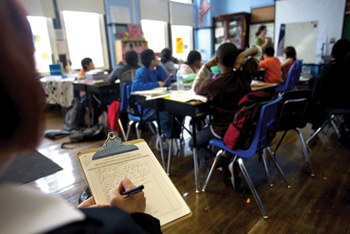
The purpose of this system is to develop teachers’ teaching ability and methods. Students, parents, and fellow teachers evaluate the teacher’s overall educational activities. The introduction of the system was discussed in 2000, and the MEST (Ministry of Education & Science Technology) began conducting model operations at 48 schools in 2005. The system has been in operation in all elementary, middle, and high schools since March 2010.
A teacher evaluation system started at all elementary, middle, and high schools in March this year, but the issue remains hotly in dispute. I will demonstrate the advantages of the teacher evaluation system.
First, the teacher evaluation system encourages the development of teachers. When we get bad exam results, we try to get better than before. Like this, the system makes teachers develop and know their needs, and try to make up for them. Therefore, students can get better classes than before.
Second, the system reinforces public education. With the extraordinary increase of private education, students and their parents have ignored public education. To increase the importance of public education, schools should provide prepared and systematic education which students are content with. Through the system, teachers might prepare classes more and the quality of classes will get higher. Therefore, it will be helpful in reinforcing public education.
Finally, the example of Gaya High School, which started the system in 1995, shows that the system is effective for both teachers and students. Gaya High School shows 7 positive effects, such as creating favorable conditions for students and improving the quality of classes through more teacher preparation, reflecting parents’ opinions through open classes twice in a month, and idea exchange between teachers through evaluating each other.
The teacher evaluation system gives various positive effects. It will give teachers an opportunity to develop their teaching abilities and give students the opportunity to receive high quality classes because the results of teachers’ evaluation are reported to teachers. The teachers later draw up plans about how to develop their ability and submit the plans to their principals. Finally, schools and the MEST evaluate teachers’ plans and evaluation and they give training to teachers who need it. The system will also reinforce public education and secure parents’ trust because committees for the management of teacher evaluation will be established in schools and the MEST. In addition, the OECD (Organization for Economic Cooperation and Development) recommended the system. Improving the quality of education through the system will be beneficial to the competitive strength of Korea, so I agree with the system.
By Kang Areum-songyi
KMG Reporter
annieks22@kmu.ac.kr
KMG Reporter
annieks22@kmu.ac.kr
The Teacher Evaluation System, which has been enforced in middle and high schools since March 2010, is an evaluation system for evaluating teachers’ qualifications with objective standards. However, I oppose this system because of the following problems.
First, the evaluation standards are not objective. If the standards are unfair and subjective, the system evaluates the teacher’s popularity, not a teacher’s qualification. In addition, if the parent’s evaluation points are reflected, the system will produce a bad result that teachers teach to get good results or points from the teacher evaluation system, trying to meet students’ or parents’ taste.
Next, foreign cases demonstrate that the system is irrational. In America, around 20 states have enforced a teacher evaluation system. This system evaluates how teachers have contributed to students’ academic achievement. However, it included potential problems that teachers’ teaching styles are standardized by obsessing over the results of the evaluation. In England, a progressive educational policy which gives empowerment to schools has operated since 2001. The British government has authorized principals to hire and fire teachers. The government made public every school’s grades and ranking, and also the pay is commensurate with grade. However, it caused negative results. Many teachers changed their job to avoid unreasonable competition. To meet the needs for teachers, the government is hiring foreign teachers.
Finally, the public education problem is not caused by teachers. The collapse of public education is caused by putting emphasis on school name, distorted enthusiasm of the parents, the college admission system, and the number of students per teacher. The government has to fix the harsh educational conditions of public education before evaluating teachers.
The purpose of the teacher evaluation system is good, but we need to consider applying it more carefully to our educational field. The purpose of teacher evaluation, the evaluation of teaching techniques, is a short-sighted and impractical idea. Reducing private education and vitalizing public education through this system are unrealistic.
By Lee Kyung-min
KMG Reporter
kmlw77@kmu.ac.kr
KMG Reporter
kmlw77@kmu.ac.kr








